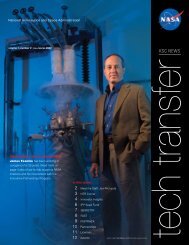2006-2007 - Kennedy Space Center Technology Transfer Office
2006-2007 - Kennedy Space Center Technology Transfer Office
2006-2007 - Kennedy Space Center Technology Transfer Office
- No tags were found...
Create successful ePaper yourself
Turn your PDF publications into a flip-book with our unique Google optimized e-Paper software.
a compatible spacecraft model where the NTCcan be calculated and compared with flight data.This proven process will be a valuable tool forquickly examining both traditional and novelmechanical fuel slosh analogs and for allowingspacecraft designers to build accurate sloshmodels early in the design phase, when potentialNTC violations can be avoided.Contacts: James E. Sudermann , NASA-KSC, (321) 867-8447; andKeith L. Schlee , AnalexCorporation, (321) 867-4186Participating Organization: Southwest ResearchInstitute (Dr. Steve Green and Russell C. Burkey)Figure 4. Overall layout of on-axis SSTR SimMechanics model.comparing their results with experimental results. Astrong desire exists to automate this method so differentanalogs can be tested quickly and the results can becompared with measured data.The method presented accomplishes this task by usinga MATLAB Simulink/SimMechanics-based simulationwhere the parameters are identified by the ParameterEstimation tool. Simulink Parameter Estimationprovides a graphical interface where several optimizationalgorithms can be selected. The simulation incorporatesthe same slosh analog used by SwRI, two torque rotorsabout the radial (x) and tangential (y) axes (Figure 4),allowing direct comparisons between the hand-derivedand automated methods. Six sets of measured data canbe supplied to the simulation for parameter estimation.These include forces (Fx/Fy) along the tank wall andtorques (MR/MT) resolved to the tank center of gravity(CG) (Figure 5), as well as the angular velocities ofthe tank CG (Ωx/Ωy) about each axis. Each nutationsweep test, usually consisting of 9 to 11 individualnutation frequencies, is supplied to the Estimator, whereits multiple dataset estimation feature can be used.Estimating to the entire set of measured data allows therotor parameters to be optimized for reproduction of thetorque resonance response over the entire range of testednutation frequencies (Figure 6).Current research efforts focus on identifying andrecording the differences between the hand-derived andSimMechanics methods, such as the effects of largerrotor inertias. Once complete, the same SimMechanicsanalog used in the SSTR model will be incorporated intoForce (lb) / Moment (in.lb) / Angular Velocity (rad/s)100806040200–20–40–60–80–10020 20.5 21 21.5 22 22.5 23 23.5 24 24.5 25Time (s)Measured FX Simulated FX Measured FY Simulated FYMeasured MRSimulated MRMeasured MTSimulated MTFigure 5. Comparison between measured and simulation dataat a nutation rate of 0.44 for typical PNH test (upper-motorRPM = 26.26, lower-motor RPM = 34.30).Phase Difference: MR–ΩY (deg)8765432100.0 0.1 0.2 0.3 0.4 0.5 0.6 0.7 0.8 0.9 1.0Nutation Frequency / Spin RateMeasuredLow Rotor Inertia Limits (lx=ly=2,750)Converged Rotor Inertias (lx=10,191, ly=10,463)SwRI Rotor Inertias (lx=1,400, ly=1,500)Medium Rotor Inertia Limits (lx=ly=4,000)Figure 6. MT-to-WY phase comparison using variousestimated parameters (inertia unit: lb.in 2 ).KSC <strong>Technology</strong> Development and Application <strong>2006</strong>-<strong>2007</strong>83













